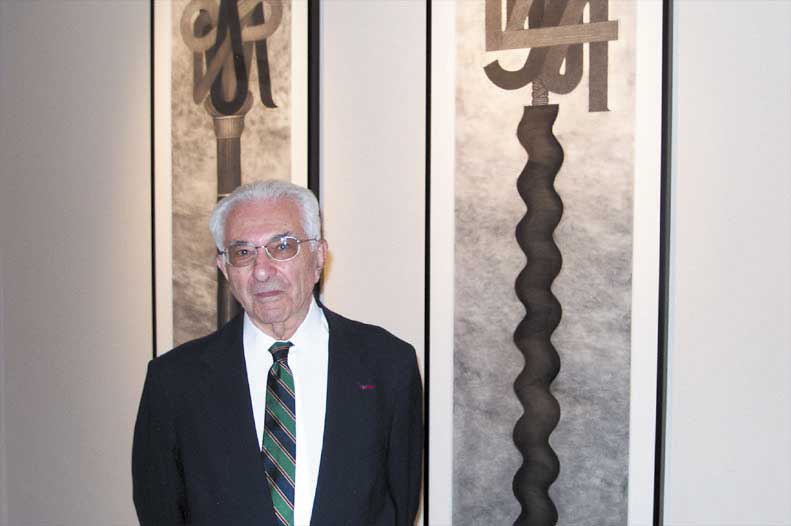Zhanna Bagdasarov
Editor
 His name has been linked with the revival of creative lithography in the United States for over fifty years and his contributions to the world of art are undeniably immense. Mr. Garo Antreasian’s exhibit at the Fresno Art Museum finally shared his acclaimed paintings, drawings, and prints with a Fresno audience, September 6, 2005-October 30, 2005.
His name has been linked with the revival of creative lithography in the United States for over fifty years and his contributions to the world of art are undeniably immense. Mr. Garo Antreasian’s exhibit at the Fresno Art Museum finally shared his acclaimed paintings, drawings, and prints with a Fresno audience, September 6, 2005-October 30, 2005.
Walking into the museum on the eve of the artist’s lecture, I was immediately confronted with a magnificent view of Antreasian’s large works. The entire museum appeared alive with geometric elegance, which is evident in most of his designs.
While taking a closer look at the works on display before the lecture, one question arose in my mind, “What could possibly serve as the artist’s motivation and influence to create such elaborate art pieces?” It was as though the artist knew precisely what was of interest to his audience because he not only answered that question, but also covered his life’s journey.
The hour-long lecture took place on Thursday, October 27 at 5 PM and was immediately followed by a reception. My question was answered little by little throughout the lecture, yet it was the beginning of the lecture that touched on Antreasian’s influences the most. He spoke at length about his background, which consisted of being born in Indianapolis to Armenian parents. His father was a revolutionary and his mother and grandmother were both survivors of the terrible Armenian genocide of 1915. It was his father who insisted on beginning a new life in America, yet his mother and grandmother were determined to maintain their Armenian cultural heritage. Thus, Antreasian was taught to speak Armenian at home, he ate Armenian cuisine and scarcely spoke English until entering grade school. As a young boy, he spent much of his time reading and day-dreaming, which in turn became the crucial aspect of his later career in art. Nonetheless, he admits that his art was greatly influenced by the two cultures he experienced while growing up.
Antreasian acquired his first set of oil paints due to the exhaustive efforts of his sixth grade teacher, who talked his parents into investing in these instruments. His first art-related experiences included painting in the company of elderly ladies every Saturday. It wasn’t until his high school years however, that Antreasian was introduced to lithography and began his life-long efforts to try and revive it in the United States. As soon as he entered the John Herron School of Art, Antreasian found better lithography equipment than at the high school, yet was disappointed to find the needed courses discontinued. Thus, throughout his life, Antreasian would experiment with lithography technology in hopes of perfecting it.
After completing his BFA degree at Herron, he was offered a teaching position there and remained for 16 years, during which he initiated new courses in design, advanced composition, print-making, and advanced drawing and painting. For the next few years, the artist made incredible progress in regards to technology, new materials and equipment and stimulating interest among new artists. Antreasian’s big break came at the time he was invited to join the newly established lithography program at the University of New Mexico. It is here that his works adopted a more abstract, hard-edged and simple approach, yet it was more demanding technically.
According to the artist, he was also very much influenced by the art of other cultures. His trip to Brazil and Turkey sparked an interest in decorative and Islamic art. This also brought about a need to paint again, which is something he hadn’t done due to his interests in printmaking. Retirement in 1987 allowed the artist to rejoin the art of painting, which is something he urged to do after a lengthy break. He began to draw again and his works reached a height of six feet and larger. It is these large pieces of art that one couldn’t help but notice walking into the museum.
This lecture shed some light upon aspects of the artist’s life that are the missing pieces to this artistic puzzle. When listening to Antreasian’s account of his journey through time, one was able to begin to understand the way his experiences, literature, dual cultural backgrounds and works by other artists, have shaped every stroke of his brush, every choice of color, as well as his ideas and themes.
 Hye Sharzhoom Armenian Action
Hye Sharzhoom Armenian Action